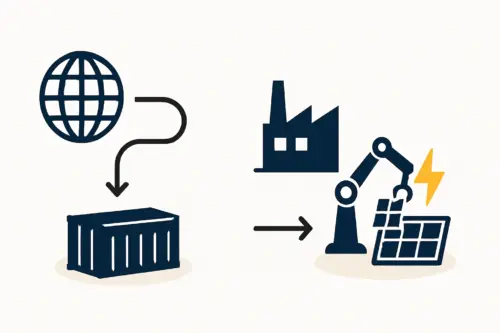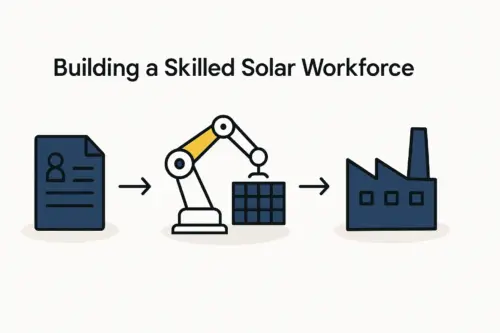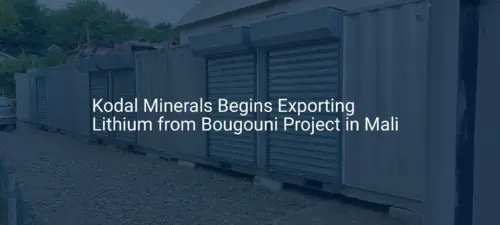For an entrepreneur establishing a solar module factory, the sight of state-of-the-art machinery being installed is a milestone. But that equipment is only one part of the equation.
The most sophisticated production line sits idle without a consistent, reliable flow of raw materials. For a venture in a landlocked country like Mali, managing this supply chain is not just an operational task—it is a strategic challenge that can determine the success of the entire project.
This article examines the logistical realities of transporting essential raw materials for solar panels from international suppliers to a manufacturing site in Mali, outlining the primary transport corridors, typical costs, and crucial planning considerations for professionals entering this industry.
THE GEOGRAPHIC REALITY: MALI’S RELIANCE ON COASTAL CORRIDORS
Mali’s landlocked position means that all sea-freighted goods must transit through the ports of neighboring coastal nations. This geographic reality introduces multiple layers of complexity, cost, and potential delay that must be factored into any business plan.
The primary gateways for goods destined for Bamako are the ports of Dakar in Senegal, Abidjan in Côte d’Ivoire, and, to a lesser extent, Tema in Ghana and Lomé in Togo. Each of these corridors presents its own combination of advantages and disadvantages related to distance, infrastructure quality, and administrative efficiency. The choice is not simply about the shortest route but involves a calculated assessment of risk and reliability.

The journey from the port to the factory gate is often the most challenging leg of the supply chain. This part of the journey involves navigating different road conditions, rail systems, customs jurisdictions, and potential security checkpoints.
A COMPARATIVE ANALYSIS OF KEY IMPORT ROUTES
Understanding the nuances of each major trade corridor is essential for effective planning. While conditions can change, the Dakar-Bamako and Abidjan-Bamako corridors remain the most frequently used routes for freight moving into Mali.
The Dakar-Bamako Corridor (Senegal)
Historically, the port of Dakar has been a principal entry point for Malian imports. The corridor is supported by both a road and a rail line, though the railway’s operational capacity can be inconsistent.
Advantages: Well-established route with experienced logistics providers.
Challenges: Road quality can vary significantly, leading to longer transit times. Port congestion in Dakar can also cause initial delays before goods even begin their inland journey.
Ready to make big Profits?
The solar Industry is Booming
WE HELP NEWCOMERS to the solar industry start their own solar module production line. Customers can make BIG PROFITS by selling modules and finding investors, without wasting money and time on things they don't need!
The Abidjan-Bamako Corridor (Côte d’Ivoire)
The port of Abidjan has emerged as a highly competitive alternative, often favored for its efficiency and modern infrastructure. The road network connecting Abidjan to Bamako is generally in good condition, allowing for more reliable transit times.
Advantages: Efficient port operations and a well-maintained road network.
Challenges: The route is longer than the Dakar corridor, which can influence final transport costs.

Based on J.v.G. Technology’s experience with turnkey solar module factory projects in emerging markets, a dual-corridor strategy is often adopted to mitigate risk, using one primary route while maintaining a relationship with a provider on a secondary route as a contingency.
DECONSTRUCTING THE COSTS AND TIMELINES
For investors, understanding the true landed cost of raw materials is critical. Logistics in this region can be a significant expense, with studies indicating that overland transport can account for 30-40% of the total value of imported goods.
Key Financial Considerations:
- Ocean Freight: The cost of shipping a container from Asia or Europe to a West African port.
- Port Handling and Storage: Fees for unloading the container, customs inspection, and storage (demurrage) if clearance is delayed.
- Customs Duties and Taxes: Import tariffs specific to Mali and any transit fees levied by the coastal country.
- Overland Freight: The cost of truck or rail transport from the port to the factory in Bamako. This is often the largest and most variable component.
Timeline Expectations:
The journey from port to factory can take anywhere from two to four weeks, but this is an optimistic baseline. Delays are common, stemming from customs processing, documentation errors, road conditions, or vehicle breakdowns. Proper factory layout planning must account for this variability by including sufficient warehouse space to hold several weeks or months of buffer stock.
MATERIAL-SPECIFIC CHALLENGES: SOLAR GLASS AND EVA FILM
Not all raw materials travel equally. The physical properties of key components in the solar panel manufacturing process require their own logistical considerations.
Solar Glass: This is the heaviest and most fragile component. It requires specialized handling to prevent breakage, which can render an entire shipment useless. The weight of glass crates also impacts transport costs and vehicle selection.
EVA (Ethylene Vinyl Acetate) Film: This polymer is sensitive to heat and humidity. During long transits through hot climates, containers must be properly ventilated to prevent the material from degrading before it reaches the production line.
Careful coordination with a freight forwarder experienced in handling these specific materials is non-negotiable.
RISK MITIGATION THROUGH STRATEGIC PLANNING
While the challenges are significant, they are manageable with foresight and a robust logistics strategy. A reactive approach, where problems are handled as they arise, is a recipe for costly production stoppages.

Proactive Strategies Include:
- Partner Selection: Engage a reputable, experienced freight forwarder and customs broker with a proven track record in the region. Their local knowledge is invaluable for navigating bureaucracy and preempting common issues.
- Buffer Inventory: Maintain a strategic reserve of critical raw materials at the factory. This provides a cushion against unforeseen supply chain disruptions and allows production to continue uninterrupted.
- Route Diversification: Assess the viability of using more than one import corridor to avoid over-reliance on a single route that could be affected by political instability or infrastructure failure.
- Understanding Regional Policies: Stay informed about ECOWAS (Economic Community of West African States) trade policies, which can influence tariffs and promote regional sourcing opportunities as they develop.
FREQUENTLY ASKED QUESTIONS (FAQ)
Which port is the best choice for supplying a factory in Mali?
There is no single ‘best’ port. The optimal choice depends on a balance of factors, including port efficiency, current road/rail conditions, shipping line costs, and the specific needs of the cargo. Abidjan is often cited for its modern infrastructure, while Dakar has long-standing logistical networks. A thorough analysis with a logistics partner is essential before committing to a route.
How much buffer stock of raw materials is recommended?
A general guideline for a new factory is to hold enough critical raw materials to cover two to three months of production. This figure can be adjusted based on the reliability of the established supply chain, seasonal transport challenges (such as the rainy season), and the factory’s risk tolerance.
Are there opportunities to source materials regionally within West Africa?
Currently, specialized materials like solar-grade glass, cells, and EVA film are primarily sourced from established international manufacturers, mostly in Asia. However, ECOWAS policies are designed to encourage regional industrial development. Over time, regional suppliers for components like aluminum frames or junction boxes may emerge, which would significantly reduce logistical complexity for these items.
What is the most common ‘hidden cost’ in this supply chain?
Demurrage and detention fees are among the most frequent and costly hidden expenses. These charges are levied by shipping lines when a container is not cleared from the port and returned within a specified free-time period. Delays in customs are a primary cause, highlighting the critical importance of accurate documentation and an efficient customs broker.
CONCLUSION: LOGISTICS AS A CORE BUSINESS COMPETENCY
For any entrepreneur planning to enter the solar manufacturing sector in Mali, developing a deep understanding of logistics is not optional—it is a core business competency. The path from a coastal port to a factory floor is fraught with potential obstacles, but with diligent planning, strategic partnerships, and a proactive approach to risk management, a reliable and cost-effective supply chain can be established. This foundation is essential for ensuring the long-term operational stability and profitability of the venture.






